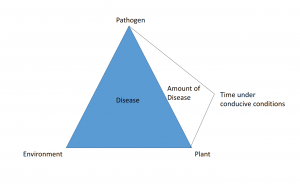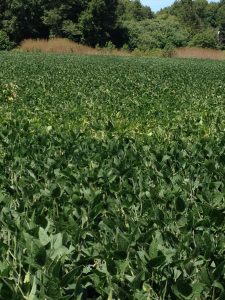The harvest in 2018 has been marred by frequent rains that resulted in soybeans in portions of the state being left out longer than desired. As expected, more attention to these unharvested beans resulted in more observations. One common observation was the presence of various types of black growth on stems of senesced plants, and the concern that these symptoms indicate the presence of some sort of yield-limiting pathogen. What are some of the potential players and how can you tell them apart?
The first thing to realize is that after plants senesce, they basically turn into a Golden Corral for all sorts of microbes, especially fungi. Dead, senesced tissues are full of digestible carbon and nutrients that many saprophytic fungi use to grow and reproduce. These fungi are not pathogens, and do not cause any yield losses. This is part of the problem with attempting to diagnose an issue when plants are brown and dry, because if a pathogen was present, it may not be detectable with the bevy of saprophytic fungi growing on dead tissues.
If you were out in the field earlier in the season, before all your plants were brown, you may have observed symptoms and signs of actual pathogens that could impact your bottom line. This season we heard of several reports of stem canker in parts of the state. Stem canker is caused by a complex of fungi belonging to the Diaporthe complex. These pathogens survive in residue for years and will produce spores during persistent wet conditions. Infection of the nodes occurs early in the season, typically before R1. After a few weeks, the development of small red spots may be observed near the base of petioles and nodes. These spots expand and eventually produce sunken cankers that appear brown or red. These cankers can extend up the length of the stem, girdling the conductive tissues, resulting in reduced water and nutrient uptake, pod and seed development, and potentially plant death.
Another disease that was encountered was Pod and stem blight. This is another predominantly residue-borne fungal disease caused by Diaporthe spp., although the inoculum can also be harbored on/in infected seeds. The disease is very similar to stem canker in how it infects and when symptoms develop. In the case of pod and stem blight, you will see linear rows of black dots on the stem. In addition, plants affected by pod and stem blight, as the name implies, may have infected pods. If the weather is wet between R5-R7, fungal spores can infect pods and colonize developing beans. Infected beans become shriveled and white. This year, we saw a fair amount of pod and stem blight, which was confused with frogeye leaf spot by some individuals. Beans infected by the frogeye leaf spot fungus (Cercospora sojina) typically have a purple discoloration, and are not shriveled and white.
A final disease that was observed in some areas was anthracnose, caused predominantly by the fungus Colletotrichum truncatum. This isn’t really something that causes widespread yield losses, but if seeds are infected, you may observe early season stand issues. Infected seeds also may have reduced quality. Spores of this fungus are dispersed under persistent humid weather and can infect plants at any stage in development. Symptoms may not be evident until later in the season or until conditions are warm and humid. Late season symptoms include brown, sunken cankers on the stems, brown/greyish lesions on the pods, and irregularly arranged dots on the stems and pods. If you look at these with a hand lens or microscope, you will see setae, or little black spines that resemble eyelashes.
During the season, there are many diseases that could potentially impact your crop. It is a good idea to routinely scout your fields. Once plants are brown and dry, it is nearly impossible to determine what the cause of the issue was, if one even existed.


